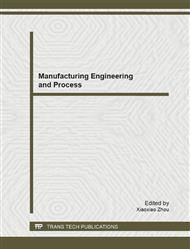[1]
L. Cheng and T. Chen (2001) Flow boiling heat transfer in a vertical spirally internally ribbed tube, Heat and Mass Transfer 37 (2001), p.229–236.
DOI: 10.1007/pl00013294
Google Scholar
[2]
. Lixin Cheng and Tingkuan Chen (2005) Study of vapor liquid two-phase frictional pressure drop in a vertical heated spirally internally ribbed tube. Retrived online 30th January, 2010 from www. sciencedirect. com.
DOI: 10.1016/j.ces.2006.10.016
Google Scholar
[3]
Chang Ho Kim and Soon Heung Chang (2009) CHF characteristics of R-134a flowing upward in uniformly heated vertical tube. Retrived online 25th February, 2010 from www. sciencedirect. com.
DOI: 10.1016/j.ijheatmasstransfer.2004.12.025
Google Scholar
[4]
Collier and J.R. Thome (1994) Convective Boiling and Condensation, Oxford University Press, New York (1994).
Google Scholar
[5]
R. Kamali and A.R. Binesh (2008). The importance of rib shape effects on the local heat transfer and flow friction characteristics of square ducts with ribbed internal surfaces. Retrived online 27th February 2010 from www. sciencedirect. com.
DOI: 10.1016/j.icheatmasstransfer.2008.04.012
Google Scholar
[6]
D.F. Dipprey and R.H. Sabersky (1963) Heat and momentum transfer in smooth and rough tubes at various Prandtl numbers, Int. J. Heat Mass Transfer 6 (1963), p.329–353.
DOI: 10.1016/0017-9310(63)90097-8
Google Scholar
[7]
R.L. Webb, E.R.G. Eckert and R.J. Goldstein (1971) Heat transfer and friction in tubes with repeated rib roughness, Int. J. Heat Mass Transfer 14 (1971), p.601–617.
DOI: 10.1016/0017-9310(71)90009-3
Google Scholar
[8]
Y.M. Zhang, W.Z. Gu and J.C. Han (1994) Heat transfer and friction in rectangular channel with ribbed or ribbed-grooved walls, ASME/J. Heat Transfer 116 (1994), p.58–65.
DOI: 10.1115/1.2910884
Google Scholar
[9]
J.A. Almeida and P.R. Souza Mendes (2008) Local and average transport coefficients for the turbulent flow in internally ribbed tubes. Retrived online 27th February 2010 from www. sciencedirect. com.
DOI: 10.1016/0894-1777(92)90038-7
Google Scholar
[10]
Lixin Cheng and Tingkuan Chen (2009) Study single phase flow heat transfer and friction pressure drop in a spirally ribbed tube. Retrived online 27th February 2010 from www. sciencedirect. com.
Google Scholar
[11]
Mott, R. L. (2006) Applied Fluid Mechanics, 6th ed., Prentice Hall, NJ (2006).
Google Scholar
[12]
Iwabuchi, M., Tateiwa M., Haneda, H., (1982) Heat transfer of rifled tubes in the near critical pressure region. 7th internat heat transfer conference, Munich 1982, p.313 – 318.
DOI: 10.1615/ihtc7.4590
Google Scholar
[13]
Kolhor, H. and Kastner, W., (1986). Heat transfer and pressure loss on rifled tubes, 8th Internat. Heat trasnfer conference, San Francisco, Vol. 5, 1986, p.2861 – 2865.
DOI: 10.1615/ihtc8.1380
Google Scholar
[14]
Kline, S.J. and McClintock, (1953). Describing uncertainties on single – sample experiments, Mechanical engineering, 57 (1953) 3 – 8.
Google Scholar
[15]
Katto, Y., (1978). A generalized correlation of critical heat flux for the forced convection boiling in vertical uniform heated round tubes, Internat.J. Heat Mass Transfer. 21 (1978) 1527 – 1547.
DOI: 10.1016/0017-9310(78)90009-1
Google Scholar
[16]
Webb, R. L. et. al. 91971) International heat mass transfer 1971, 14, 601.
Google Scholar
[17]
Wakinston, A. P. and Miletti, D. L., (1973) AIChE symposium ser. 1973, 69 (131), 94.
Google Scholar
[18]
Marto, P. J and Peilly R. J. et. al. (1979) Advances in enhanced heat transfer, ASME, New York (1979).
Google Scholar
[19]
Withers, J. G (1980). Heat transfer engineering. 1980, 2 (1), 48.
Google Scholar
[20]
Arrillaga J., and Smith B. C., et. al (1997). Power sustems Harmonics Analysis, John Wiley (1997).
Google Scholar
[21]
Callaghan, C, D., (1989). Three phase integrated load and harmonic flows, Ph. D. Thesis, University of Canterbury, Christchurch, New Zealand, (1989).
Google Scholar
[22]
Courant and Friedrichs (1948) Supersonic Flow and Shock Waves, published by Interscience Publishers, Inc. New York, (1948).
Google Scholar
[23]
Bergles A. E. and Rohsenow W. M. (1994) The determination of forced convection surface– boiling heat transfer, ASME, J. Heat Transfer, vol 1 p.365 – 372.
DOI: 10.1115/1.3688698
Google Scholar
[24]
Genick Bar-Meir (2008). Fundamentals of compressible flow mechanics, Ph. d. Minneapolis, Minnesota October 8, (2008).
Google Scholar


